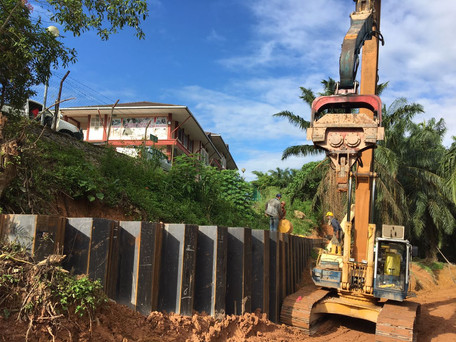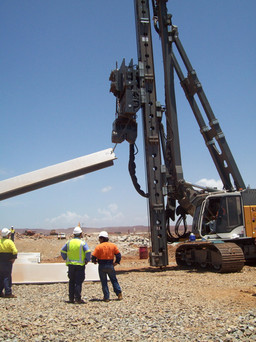Quality Control Measures for Sheet Pile Installation
- ESC Steel LLC
- Sep 6, 2021
- 5 min read
Updated: Jun 22
Through many years of pioneering as a global piling company, ESC has developed a comprehensive sheet piling guide obtained from vast theoretical research and extensive practical experience that adheres to various standards such as EN 12063-1999. This European Standard covers the implementation of special geotechnical engineering work, which is also known as the “Execution of Special Geotechnical Work – Sheet Pile Walls”.
ESC treats every sheet piling operation as a unique activity that depends ultimately on distinct parameters dictating the set of necessary quality control measures for sheet piles as individual material and as an integrated sheet pile wall or system. However, basic quality control requirements can be categorized as follows:
General
Prior to the physical works/ installation of the sheet piles, construction methodologies should be in accordance with the design of the sheet pile and various components of the retaining wall system. During sheet pile installation works, the following factors shall be considered and checked at different stages of the project:
1. Levels and tolerances for filling and excavation
2. Levels and tolerances for groundwater and surface/free water
3. Properties and quality of the backfill material at the retained side of the sheet pile wall
4. The displacements along the sheet pile that resulted from different phases of the driving/installation works
5. Limits on surcharge loading, as defined during the analysis/design phase of the project
Should the established construction methodologies not be able to be implemented straightforwardly, a revision shall be made to ensure the proper installation of sheet piles based on actual site conditions. In addition, each sheet pile shall be referenced.
Stacking & Handling

Sheet piles shall be stored in such a way that the individual sheet piles can easily be lifted, depending on the sheet pile type to be installed for a particular construction phase. Sheet piles shall be stacked with spacers to prevent any damage and/or distortion to the individual sheet pile wall panels. Special care shall be taken to account for sheet piles with paint/coating applied to the surface.


For vinyl, ESC-V series Omega Piles, the most effective stacking configuration is to make 2 columns of sheet piles stacked together. The Female ‘C’ connectors are kept on the inside, and the male ‘T’ Connectors are oriented to the outside. For Z-shaped sheet piles, the piles are typically stacked diagonally, with alternating connectors. This also makes driving more straightforward as the piles are progressively picked up from one side and are in the correct orientation.
During the lifting and positioning process of the sheet piles, special equipment and accessories should be included in the pile installer’s tool set. Quick ground release shackles (GRS) enable the pile installer to release the connection between the sheet pile and the crane at the ground level. The use of GRS provides a safe lifting procedure by eliminating the need for the technician(s) to climb ladders to release the lifting device from the sheet pile.
Equipment Selection

ESC recommends that all piling operations be performed using a vibratory hammer. Vibratory hammers have long been proven to be the most efficient and common method of pile installation. Diesel hammers perform especially well in cohesive or very dense soil layers. Under normal site conditions, it is usual to select a ratio of ram weight to weight of pile plus cap of 1:2 to 1.5:1. Driving caps of flat anvil blocks are necessary to protect the pile heads during driving.

The hydraulic hammer can operate at any angles, above and below water level, and is suitable both for driving and extracting piles. Under normal site conditions, it is usual to select a ram weight that is in the ratio 1:1 to 1:2 with the weight of the pile plus driving cap. A heavy hammer with short drop is always preferable to minimize pile head damage.

The elimination of the noise of sheet driving, which had for years been accepted as a nuisance to be tolerated, was the original purpose of the development of sheet pile presses as an alternative to the classical methods. Originally developed to drive piles silently, the machines are also widely recognized for their vibration-free operation.
Installation
For sheet pile installation and driving works, a rigid guiding system or frame shall be used to maintain the verticality of the sheet piles. This is very important in sheet pile installation, as any significant verticality error made during installation can affect the overall design of the structure. Certain serviceability issues, such as deflections and watertightness, might arise during the construction and operation phase of the project. Guide walings are commonly used to support the sheet pile while it is being pitched into the rest of the installed piles. The walings also provide enough restraint to the pile during driving to prevent any excessive lateral bending that can cause permanent deformations.
Piling guides should always be used in the installation of ESC piles, regardless of the installation technique or the equipment used to drive the piles. If a leader is used, with the vibro mounted on a piling rig (ABI/Bauer, etc.), slide on the mast, then only a bottom guide will be required to ensure the correct positioning of the piles. If a free-hanging vibro-hammer is used with a crane, then an upper and lower guide will be required.
ESC ‘wide’ piles should be driven using the staggered method, where every second pile is driven and then the intermediate pile is slotted into the resulting gap. The pile is driven first, and the infill piles are slotted in. Sheet piles with smaller surface areas, such as ESC-HRZ and HRU piles, are driven one by one in progression, with the first sheet pile installed with great care and attention to ensure its verticality in both planes of the wall. It is essential that the following piles are interlocked sufficiently to the preceding pile before being released and the hammer applied.
For vinyl, it is generally recommended that Omega Type Piles are driven in singles, whilst Z-type piles are driven in pairs. Pairs are preferable from an alignment perspective and are less confusing, but they can also be driven in singles to increase the applied driving load capacity per pile.
Tolerances
Certain tolerances in terms of the sheet pile’s position must be observed as installation works commence. Displacement of the pile perpendicular to the wall must be limited to prevent any unwanted construction issues in the wall system. Per EN 12063-1999, piles that are installed on land shall have a 75.00 mm displacement as the maximum allowable deviation in plan position of the pile top relative to the original position. For piles installed over water, a 100.00 mm displacement shall be set as the maximum allowable deviation of the pile top.
Verticality of the sheet pile is measured in all directions over the top 1.00 meter of the wall. For piles installed on land, a 1.00% shall be observed as the threshold value for verticality. On the other hand, piles installed over water shall have a verticality threshold value of 1.50%. It should be noted that these threshold values can be increased to 2.00% when sheet piles are installed in difficult subsurface conditions, and no strict criteria are set for watertightness and declutching issues.
Other structural elements for the retaining wall system, such as walers and struts, shall conform to the relevant provisions of EN 12063-1999. These components shall also be designed to account for adverse/ extreme loading conditions during the storage, lifting, and installation stages of the project. Should gaps be observed between the waler and sheet piles during installation, the gaps shall be filled to ensure the proper load path of the external forces into the walers. Filler material may be in the form of steel plates or wedges. Wooden or plastic wedges may also be used as fillers. Mortar-filled bags may also be used to fill in the gaps between the sheet pile and waler.
Reference: EN 12063-1999
ESC’s engineering and construction team is experienced in numerous fields with a reputation built on excellence and a commitment to continuous innovation to provide you, the client, with a combination of high-quality, economical, safe work environment and efficient solutions for many piling projects. Contact our experts now!







.png)